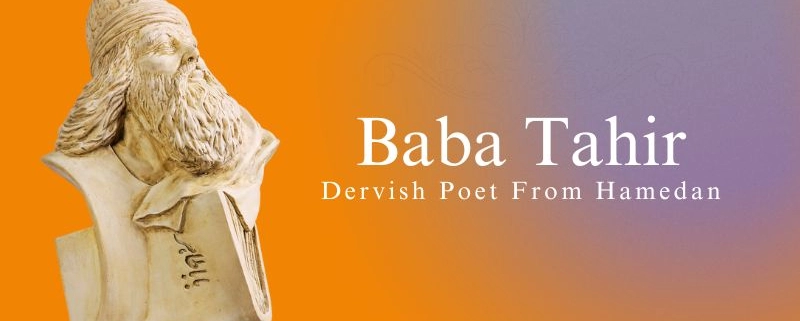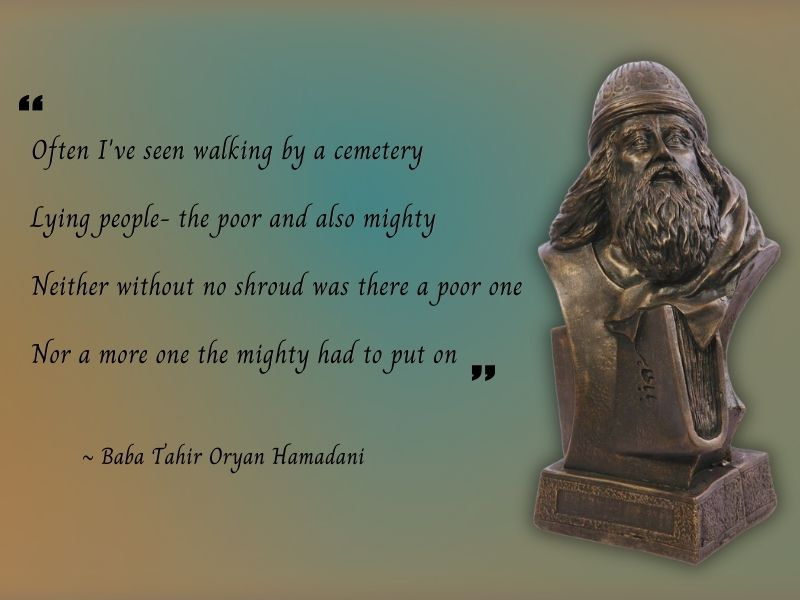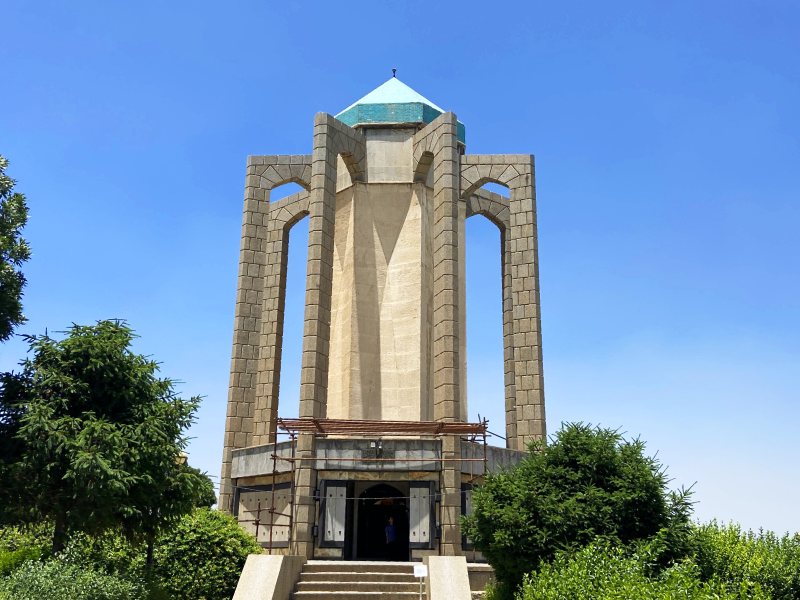Baba Tahir Oryan Hamadani (Biography, Poems, Tomb)
Baba Tahir Oryan is considered one of the eminent mystics and poets of the fifth century AH (Islamic calendar), marking a timeless figure in the history of Iranian mysticism and poetry. He became famous for his beautiful couplets, embodying profound spiritual themes. He chose a life of seclusion and showed little interest in documenting his personal experiences, which has shrouded his life in ambiguity. Now, there is no accurate information about his life. The lack of information about this great mystic caused some people to consider his character as fictitious and far from reality.
Baba Tahir was a passionate mystic, a restless soul, and a wandering ascetic who referred to himself as “Sote-Del” (the broken-hearted). His writings and songs resonated with the common people who were distant from formal education, preferring simplicity in language. His touching songs touched the hearts of both shepherds and nomads, crossing gender and social divides.
Biography of Baba Tahir
Baba Tahir Oryan Hamadani, a famous mystic and poet of the 5th century, lived at the same time as the Seljuk era. There is no exact information about his birth date and how his life began. Some consider him a contemporary of “Ain al-Qudat Hamadani” in the fifth century, and some consider him a contemporary of “Khajeh Nasir al-Din Tusi” in the sixth century AH. He lived his life in seclusion and anonymity, as well as with contentment and piety in the village of Malayer, Hamadan.
His inner purity and self-discipline can be clearly seen in his poems and couplets. Some researchers consider the date of his birth to be the last years of the 4th century AH, but there is no valid document to confirm it.
Edward Heron Allen, an English writer, called Baba Tahir a “mysterious figure” due to the lack of information about his personal life and his fame only through his couplets and aphorisms. He died in Hamadan at the age of 85 and was buried there.
Baba Tahir Nicknames
Baba Tahir was known by various titles during his life. “Baba” was his most famous title, equivalent to a spiritual guide or elder. This title, prevalent in his hometown of Hamadan, was used to honor and respect him as a sheik and other mystics.
“Oryan” was another of Baba Tahir’s titles, appearing in sources from the 9th century AH (Islamic calendar). This title indicated his detachment from worldly interests and later came to signify his simplicity and humility in public spaces. Despite his unconventional behavior alongside his ascetic spirit, these judgments did not affect the formation of these titles.
Some sources also used descriptors like “Divane,” “wise madman,” “restless,” and “infatuated” for Baba Tahir. “Luri” and “Baba Tahir Hamedani” were other nicknames that Baba Tahir was called, which refer to his ethnicity and birthplace, respectively. His Luri identity was mainly due to the presence of Luri dialect in his couplets.
Baba Tahir Poems
Baba Tahir wrote his simple couplets in two types: “popular” and “esoteric.”
The couplets that are written with a simple concept and are spoken by the common people are among the popular couplets, and the couplets that include the concepts of mysticism and Sufism are considered his esoteric couplets.
His poetic language is simple, and there is no complexity in it. He uses his pure and untainted thoughts, which came from his burned soul, fluently in his poetry to teach people humility and asceticism. The few poems left by Baba Tahir have characteristics that separate his poetic style from other poems. Simplicity, love, mysticism, wisdom, admonition, application of elements of nature, and images of fantasy are among the most important of these features.
A large part of the charm of Baba Tahir’s poetry is due to his dialect and the accent he uses in his popular poems. The fluency of the words, the pleasant melody of the words, and the simplicity of meter and rhythm are some of the beauties that Baba Tahir’s dialect gives to his poetry. His Luri couplets are considered one of the most attractive poems left by him.
Where Baba Tahir dedicates the field of speech to nature, he connects the reader with the true beauty of nature. His simple language and pure thought in describing nature, which arises from the heart, immediately touches the heart. The themes of his couplets in these poems include nature, flowers and plants, mountains and deserts, the ascetic journey, wandering asceticism, betrayal, separation, romantic passion, confession of sin, and repentance before the merciful God.
Over time, many imitations of Baba Tahir’s poems were made, and couplets were formed in Kurdish and Luri tribes in his style; for this reason, it is difficult to determine which of the couplets attributed to Baba Tahir was actually composed by him.
The Divan of Baba Tahir
There is no reliable collection of Baba Tahir’s poems, but what is considered his original compositions today is the oldest known manuscript of his poems, which has 25 verses and includes eight couplets and two verses. His couplets have been printed in Tazkereh-ye Arafat al-Ashiqin va Arsadat al-Arifin and in other memoirs, and couplets from him have also been quoted in the 12th and 13th centuries of AH.
The edition of Clement Huart, a French orientalist, is one of the first editions published in 1885, which includes 59 couplets of Baba Tahir’s poems with their French translation. In 1908, Huart Publishing House also published 28 couplets and a ghazal by Baba Tahir.
In 1902, a prose translation of Baba Tahir’s couplets was published in English, along with a translation of Elizabeth Curtis Brenton’s poems. After that, several orientalists also translated his poems into other languages.
Aphorisms
A mystical treatise by Baba Tahir has been left in Arabic called Ishrat (Signs). This treatise, which includes Baba Tahir’s aphorisms, has 49 chapters and two parts, and its theme is about knowledge, science, worship, and love.
Explanations have been written on the words of Baba Tahir Al-Arian, the most important of which is Explanation of the Words of Baba Taher Al-oryan written by Ain al-Qudat Hamadani and another one attributed to Khatib Waziri. Mulla Mohammad Gonabadi also wrote two commentaries on Baba Tahir’s aphorisms, one in Persian and the other in Arabic.
Tomb of Baba Tahir
Baba Tahir Mausoleum is located in the middle of a green area covered with trees, on top of a hill in the northwest of Hamadan city. In addition to Baba Tahir, Mohammad ibn Abdulaziz, a poet from the 3rd century AH, Abu al-Fath Asad Mihrani, a jurist of the 6th century AH, Moftoon Hamadani (Sayyid Mir Agha), a poet of the 14th century, and Mirza Ali Naqi Kowsar, a scholar of the 13th century, are also buried in this place.
The tomb of Baba Taher, which is located in a rectangular square, is an original example of contemporary architecture that has been combined with the architecture of the 7th and 8th centuries. The infrastructure and green area of the tomb have a total area of about 9,000 square meters. The tower is located on an octagonal base at a height of about 20 meters from the hill.
The mausoleum is built in a square shape with dimensions of 10 x 10 meters. Its foundations are made of stone and limestone, and the structure is made of bricks. Also, there is a turquoise-colored dome on top of it, which can be seen from a distance.
The interior of the building has its own characteristics. Baba Tahir’s beautiful poems, which are engraved on the interior of the tomb, add to the charm of the mystical atmosphere, and the tiled roof of the building, which is decorated with mosaics, has extraordinary beauty and charm. The turquoise and prismatic dome of the building has walls similar to an isosceles triangle, which unconsciously draws the viewer’s eye toward the sky. This structure shows the architect’s creativity to express the concept of ascension.
Final Word
Baba Tahir Oryan Hamadani, the renowned mystic and poet of the fifth century, captivated readers with his simple yet profound verses. His poetic language, characterized by fluidity, simplicity, and heartfelt expression, resonated with people from all walks of life. Through his poetry, Baba Tahir conveyed themes of nature, asceticism, love, betrayal, and repentance, leaving a lasting impact on Persian literature. Despite the passage of time and the proliferation of imitations, Baba Tahir’s authentic voice and timeless wisdom continue to inspire generations.
If you plan to travel to the beautiful city of Hamedan, be sure to include a visit to Baba Tahir’s tomb in your schedule.
Are you planning to travel to Iran and looking for an Iran travel agency? Check out our Iran tours and feel free to contact us.








Leave a Reply
Want to join the discussion?Feel free to contribute!